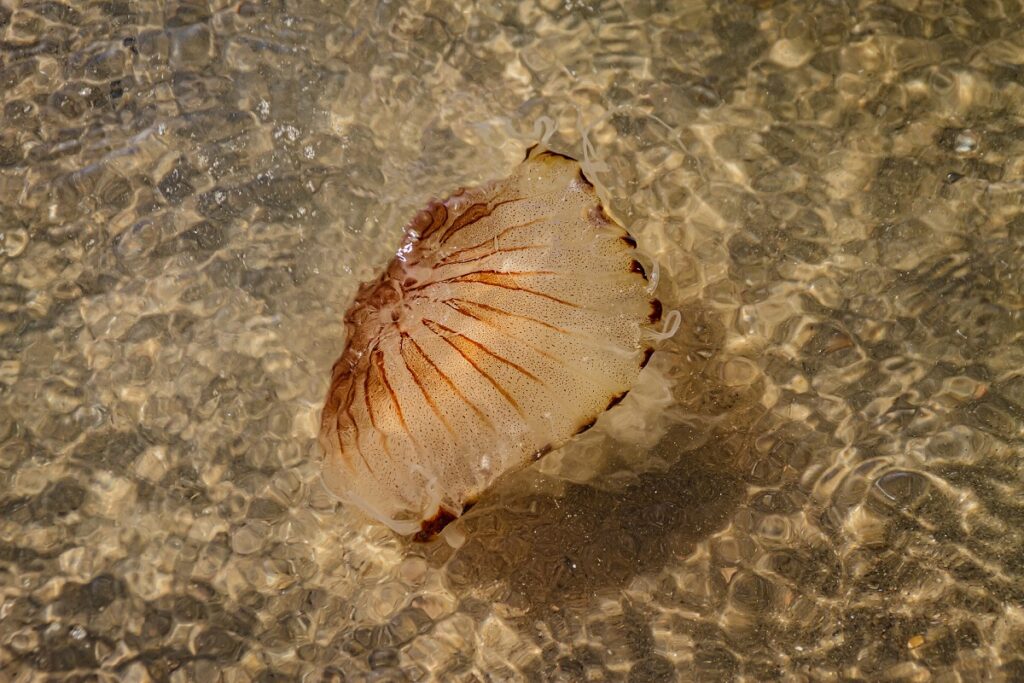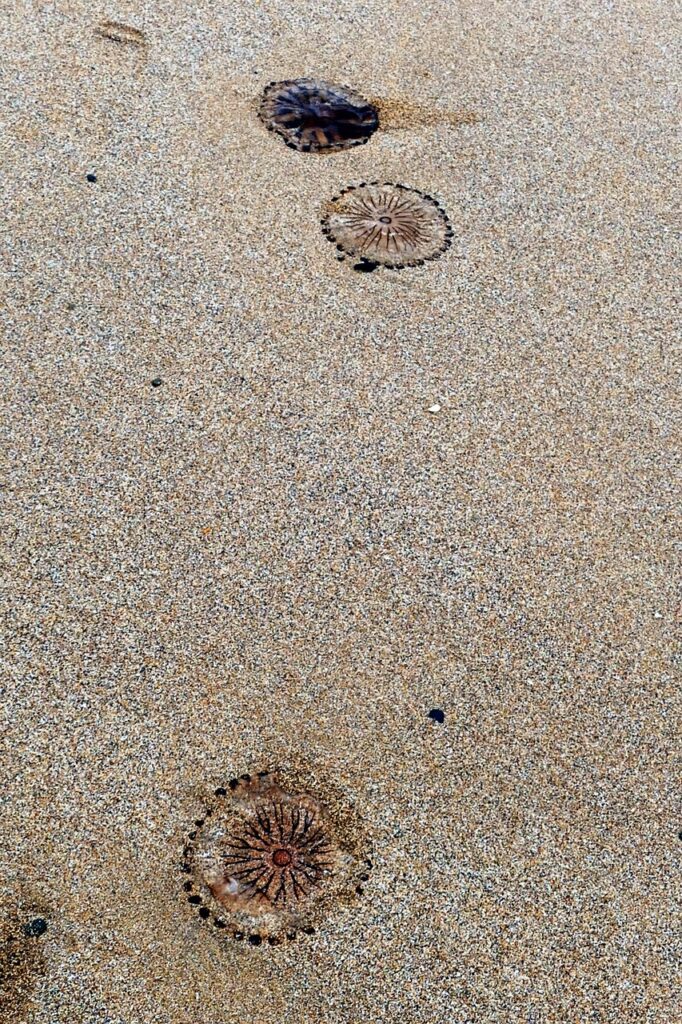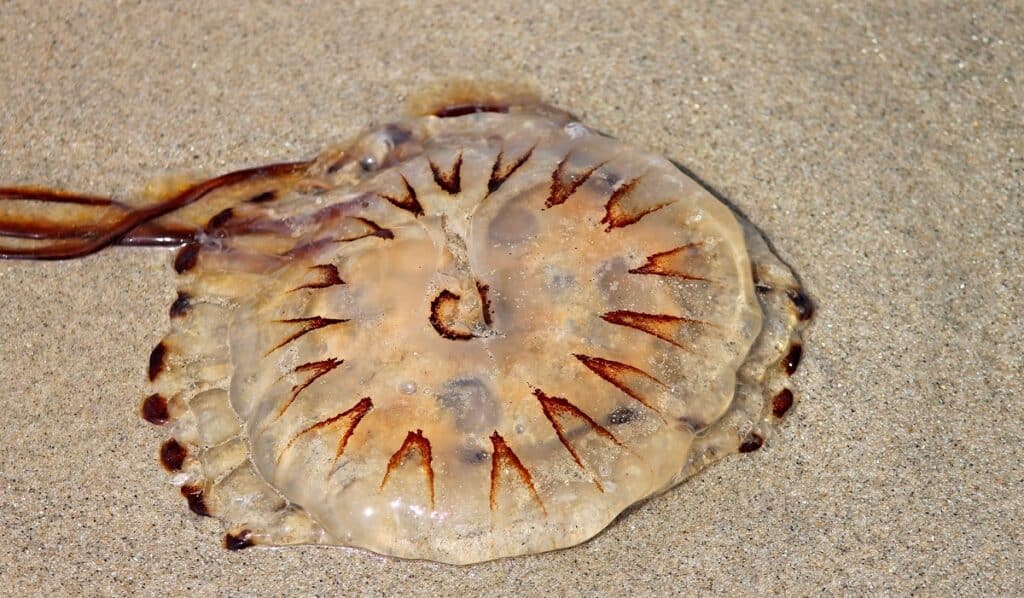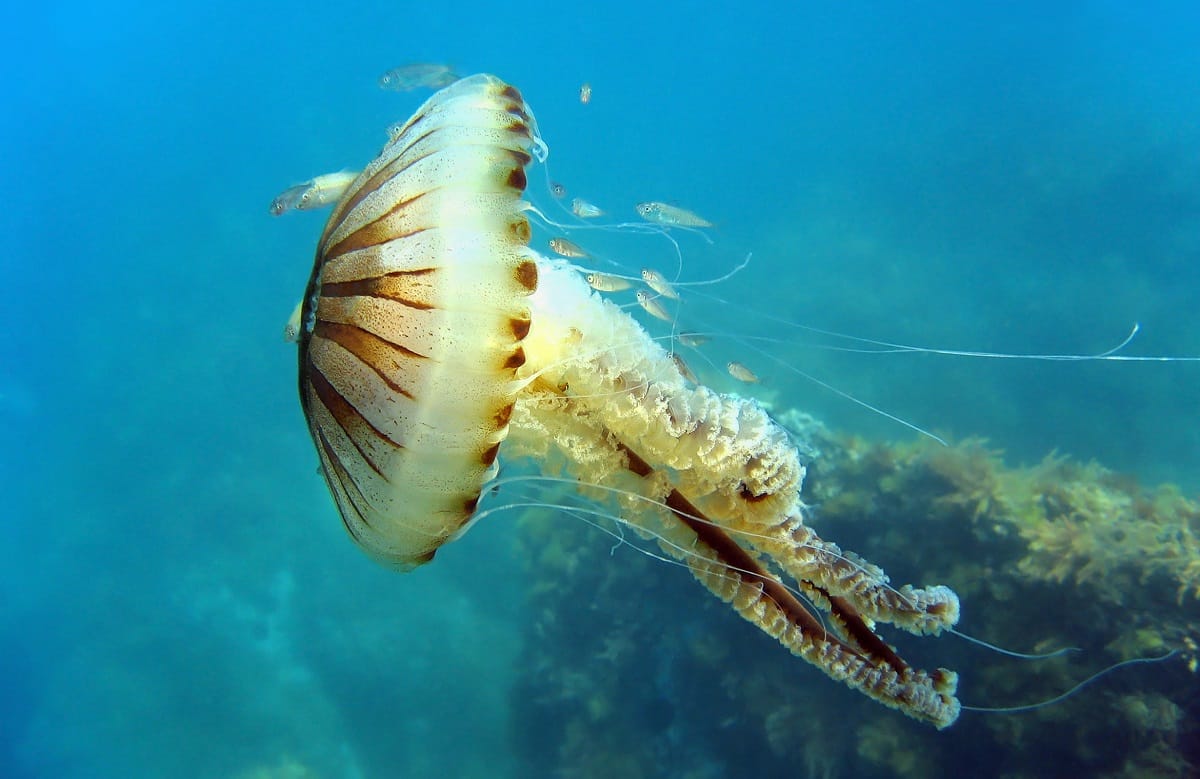Spotted (or got stung by) a long-tentacled jellyfish with a distinctive circular pattern on its bell? If you were in the northern Atlantic, North Sea or Mediterranean, the culprit was likely a compass jellyfish. Though not dangerous, this species’ tentacles unfortunately pack a punch.
Keep reading to find out more about how to identify a compass jellyfish, where they’re naturally found, and what to do if you get stung.
| Name (common, scientific) | Compass jellyfish, Chrysaora hysoscella |
| Family | Pelagiidae |
| Spread | Northeastern Atlantic and Mediterranean |
| Habitat | Up to 30m depth |
Compass jellyfish appearance
The compass jellyfish is one of 16 species in its genus, Chrysaora. These jellies are collectively referred to as sea nettles, and even if you’ve never seen one while snorkeling, you’ve likely spotted them in zoos and aquariums.
Sea nettles can be recognized by their long tentacles and bulbous bell, which can be uniform in color or feature a pattern. In the case of the compass jellyfish, Chrysaora hysoscella, its common name was derived from the dark brown, radially symmetric pattern of “V”s on the bell.
Adult compass jellyfish can reach a maximum bell diameter of around 25 cm (~10″). It’s a yellowish off-white in color and has 24 long, thin tentacles, which are arranged in eight groups of three. There are also four oral arms in the center, which are shorter and frilly.

Compass jellyfish habitat
You’re most likely to come across a compass jellyfish (Chrysaora hysoscella) if you’re swimming or visiting the beach around the northern Atlantic Ocean. They like cool waters and are particularly common around the Dutch, Belgian, French and UK coasts, inhabiting much of the North, Celtic and Irish Seas.
This being said, compass jellyfish also occur in the Mediterranean, and occasionally in the Adriatic Sea. Whether they’re present or not around the southern African coast has been a headache-inducing matter for marine scientists for a while now, with several studies having been published attempting to clarify which species in the genus Chrysaora occurs where.
The general conclusion as of now is that the sightings of Chrysaora hysoscella around the South African, Angolan, Namibian etc. coasts were actually different species. C. fulgida, which is very similar, has been identified as one of the jellyfish causing this confusion.
Unlike some other jellies, like the infamous open water-dwelling Pelagia noctiluca, compass jellyfish stay relatively close to the coast. They have been noted to be uncommon at depths below 30 meters (~100 ft).
Did you know? It’s often thought that jellyfish just kind of float around with the currents, but this is not entirely true. Many species, including this one, have been seen moving around quite a bit. It’s just that they move vertically more than they do horizontally! They can actually detect light and scents, which helps guide them.

Compass jellyfish diet
Like other jellyfish species, the compass jellyfish is a predator (that’s what those mean stings are for!). It feeds mainly on a variety of invertebrates, including copepods, decapods, ctenopods and more.
In order to capture and eat its prey, the compass jellyfish first immobilizes it using its stinging tentacles. After this, the food is moved to its mouth using the oral tentacles.
These jellyfish themselves form a food source for two iconic species that they shares their habitat with: the leatherback sea turtle (Dermochelys coriacea; the largest sea turtle species) and the ocean sunfish (Mola mola).
Planning your next snorkel trip?
Compass jellyfish facts
Sting
Unfortunately for us beachgoers and snorkel enthusiasts, each of the tentacles dangling from a compass jellyfish is equipped with relatively powerful stinging cells. If you’re reading this because you got stung, though, don’t worry: you’ll live.
Although a compass jellyfish sting can definitely be painful and leave a nasty rash, I can’t find any reports of serious problems arising as a result of people being stung.
If you got stung by a compass jellyfish (or any non-dangerous jelly, really), don’t pee on it. Don’t try to scrape off the stingers either. Instead, you can do the following:
- Pick out visible tentacle bits with tweezers
- Rinse with vinegar, or with seawater if you don’t have any
- Soak in hot water
- Apply hydrocortisone cream

Life cycle
The life cycle of most jellyfish, including this one, is quite similar. Compass jellyfish only live for around a year, first popping up in their adult form around summer. In late summer huge blooms can occur, causing trouble for beachgoers, the fishing industry and local ecosystems.
Compass jellyfish are hermaphrodites, changing from males to females after they reach maturity. Reproduction is achieved through the males releasing sperm and the females picking it up to fertilize and produce larvae.
Once the deed has been done, the jellies typically don’t live long. They die en masse in late summer and early fall and strand, sometimes coating entire beaches.
Tip: I describe the jellyfish life cycle in more detail in the fried egg jellyfish profile, so have a look if you’d like to know more about their wacky road to adulthood.
Parasites
Every animal has its own parasites, even the most basic ones. This is no different for the compass jellyfish, which is host to highly specialized parasitic amphipods from the genus Hyperia.
The Hyperia amphipods mostly live in the jelly’s gonads (reproductive organs) and on their oral arms, munching away on its host’s prey and even the host itself. This can lead to severe damage and cause the jellyfish to become unable to feed, eventually proving deadly if the infestation is severe.
Hyperia depend on jellyfish for pretty much their entire life cycle, and their numbers fluctuate seasonally along with the jellies themselves.
If you have any more questions about the fascinating compass jellyfish or if you’d like to share your own experiences with Chrysaora hysoscella, don’t hesitate to leave a comment below!

